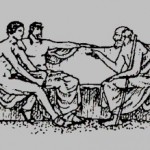Remember when I told you about that awesome New Yorker article on the professional pickpocket? Well, now they’ve got a video up of how he pulls his heists.
One thing that was particularly fun about watching this is that, although I couldn’t spot how he was doing his steals on the first go-round, I could recognize some of his ways of distracting his mark from aikido class.
The pickpocket revealed his tricks for The New Yorker, and researchers are giving up their secrets on twitter using the hashtag #OverlyHonestMethods. Here are a couple of my favorites:
@AndiFlores_ Our enzyme was proven to be stable for over 3 hours because that’s how long I forgot to put it back in the fridge #overlyhonestmethods
@dr_krystal Data was analysed using Fisher’s Exact t-test because it gave us a statistically significant p-value #overlyhonestmethods
@SciTriGrrl We used predator-stress because someone said “bring in a cat” as a joke, and I thought they were serious #overlyhonestmethods
And while we’re talking about seeing inside to the heart of the matter, check out these latex and paint art pieces by Danny Quirk. He paints anatomy right on the body.
Some of the ones at the link may not be safe for the squeamish.
The art in the last take helps make the unseen visible, but this entertaining feature article from Wired tells the story of when one of their staff writers tried to vanish.
Officially it will be another 24 hours before the manhunt begins. That’s when Wired‘s announcement of my disappearance will be posted online. It coincides with the arrival on newsstands of the September issue of the magazine, which contains a page of mugshot-like photos of me, eyes slightly vacant. The premise is simple: I will try to vanish for a month and start over under a new identity. Wired readers, or whoever else happens upon the chase, will try to find me.
The idea for the contest started with a series of questions, foremost among them: How hard is it to vanish in the digital age? Long fascinated by stories of faked deaths, sudden disappearances, and cat-and-mouse games between investigators and fugitives, I signed on to write a story for Wired about people who’ve tried to end one life and start another…
Wired offered a $5,000 bounty — $3,000 of which would come out of my own pocket — to anyone who could locate me between August 15 and September 15, say the password “fluke,” and take my picture. Nicholas Thompson, my editor, would have complete access to information that a private investigator hired to find me might uncover: my real bank accounts, credit cards, phone records, social networking accounts, and email. I’d give Thompson my friends’ contact information so he could conduct interviews. He would parcel out my personal details online, available to whichever amateur or professional investigators chose to hunt for me. To add a layer of intrigue, Wired hired the puzzle creators at Lone Shark Games to help structure the contest.
You may not be trying to track down Wired authors, but the Calvin and Hobbes search engine is likely to help you find something pretty awesome.
If you want to find a specific cartoon through the search engine above, but, if you want to find an undervalued basketball player, do you know what you should be looking for? Look, if I like a sports article, it must be pretty darn good.
Here we have a basketball mystery: a player is widely regarded inside the N.B.A. as, at best, a replaceable cog in a machine driven by superstars. And yet every team he has ever played on has acquired some magical ability to win…
Before the game, Battier was given his special package of information. “He’s the only player we give it to,” Morey says. “We can give him this fire hose of data and let him sift. Most players are like golfers. You don’t want them swinging while they’re thinking.” The data essentially broke down the floor into many discrete zones and calculated the odds of Bryant making shots from different places on the court, under different degrees of defensive pressure, in different relationships to other players — how well he scored off screens, off pick-and-rolls, off catch-and-shoots and so on. Battier learns a lot from studying the data on the superstars he is usually assigned to guard. For instance, the numbers show him that Allen Iverson is one of the most efficient scorers in the N.B.A. when he goes to his right; when he goes to his left he kills his team. The Golden State Warriors forward Stephen Jackson is an even stranger case. “Steve Jackson,” Battier says, “is statistically better going to his right, but he loves to go to his left — and goes to his left almost twice as often.” The San Antonio Spurs’ Manu Ginóbili is a statistical freak: he has no imbalance whatsoever in his game — there is no one way to play him that is better than another. He is equally efficient both off the dribble and off the pass, going left and right and from any spot on the floor.
But some mysteries don’t need too much analysis to crack:
In 1934, the second edition of Webster’s New International Dictionary came out. It was a detailed and comprehensive tome that went well beyond giving the definition of a word. It included basic etymology of a word, and some variations in spelling or pronunciation, meant to give readers a complete sense of the word and its history. The entry for “dord” included the fact that it was a noun, and that it was a term from physics and chemistry that meant density. There was no sense of what language or history it came from, or why it was a better term for density than the word “density” was.
It wasn’t long before physicists and chemists started writing in and saying that none of them had ever heard of this property called dord. Who came up with it? Where was it in scientific texts? An investigation that ended in 1939 finally uncovered a sorting error that spawned a word. The original term was “D or d,” and was bound for the stack of words meant to be in the abbreviations section of the dictionary. The capital or lower case d does often stand for density in both physics and chemistry. Somehow, when it found its way into the stack of pages meant to be words, the letters were pushed together and the word “dord” was born.
For more Quick Takes, visit Conversion Diary!















